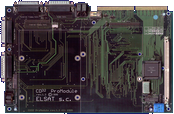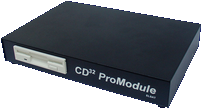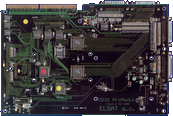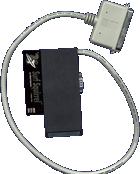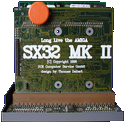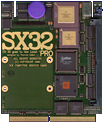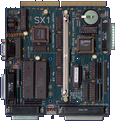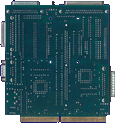Search Result
44 expansions found
Company Computer System Associates, USA | Date 1991 | Amiga A2000 | Interface CPU slot | Autoconfig ID 1058 / 17 |
- processor
- 68040 @ 25 / 33 MHz
- memory
- four 72 pin SIMM sockets accept 64 MB RAM
- supports 4 or 16 MB SIMMs (1M×32 resp. 4M×32)
- SIMM sizes can be mixed
- 1 MB burstable static RAM, soldered to the board
- 32 bit feature connector for extra memory board adding up to 128 MB RAM
- supports normal, page and burst modes
- Fast SCSI 2 controller
- NCR 53C710 controller IC
- 50 pin internal header
- DB25 external connector
- socketed resistors for SCSI termination
- LED bank indicate SCSI bus activity
- supported by NetBSD and OpenBSD
- I/O
- one DB25 RS422 compatible parallel port - plus one optional
- one DB9 RS232 compatible serial port - plus two optional
- notes
- LED bank indicate system bus activity
- programmable EPROM
- 68000 fallback mode, selectable by jumper or software
- pressing left mouse button during startup disables autoboot
- Autoboot disable switch at slot cover
- the board's autoconfiguration can be disabled by jumper
- 40_4_Magnum.pdf
user manual
146 kB
- 40_4_Magnum.dms
install disk
csascsi.device v38.76 (8 Sep 1992), csaser.device v1.52 (8 Jan 1992), csaprint.device v1.0 (28 May 92)
311 kB
Company Commodore, USA | Date 1990 | Amiga A2000, A3000, A4000 | Interface Zorro II | Autoconfig ID 514 / 69,70 |
- serial interface
- a complete computer on its own leaving the Amiga free for other tasks
- 65CE20 @ 3.58 MHz controls the I/O operations
- has 4 times the computing power of a C64
- 16 kB RAM
- the RAM is addressable by the MC680x0
- seven 8 pin mini-DIN serial ports
- not completely RS232C compatible, the RI signal (Ringing) is missing
- has jumpers for each port to exchange the RxD (Recieve Data) and TxD (Transmit Data) lines - nullmodem mode without using special cable
- seven adaptor cables with DB25 RS232C compatible serial ports supplied (80 cm long)
- 50-19200 bps transfer speed for each port
- the card is capable of 115200 bps mode but only with the supplied software
- up to five A2232 can be installed into one machine giving a total of 36 serial ports
- supported by NetBSD (normal and turbo modes) and OpenBSD
- A2232-3313.zip
driver update
serial.device v33.13 (01.08.1991)
9 kB - A2232-3311.dms
install disk
serial.device v33.11 (22.05.1990)
104 kB - a2232.dms
Installer's Heaven
install disk
103 kB - a2232tuning.lha
Installer's Heaven
driver update
23 kB
Company Applied Systems Development, UK | Date 1989 | Amiga A2000, A3000, A4000 | Interface Zorro II |
- serial and parallel interface
- up to 8 serial ports
- four MC68681 FIFO buffered dual UARTs
- up to 57600 bps transfer speed
- eight 26 pin headers for DB25 connectors
- aserial.device
- up to 4 parallel ports
- four MC6821 controllers
- four 26 pin headers for DB25 connectors
Company Eureka, Netherlands | Date 1994 | Amiga CD32 | Interface AUX port |
- links the CD32 to the serial port of any Amiga
- allows the Amiga to see the CD32 as a standard CD-ROM, though it provides painfully slow data transfers compared to a locally installed CD drive
- connects to the CD32 Aux port
- MIDI-In, MIDI-Out, MIDI-Thru connectors
- the MIDI ports are accessible from the Amiga side too
- three status LEDs showing MIDI Recieve, CD32 Send and Host Send
- the control pad emulates the mouse
- Scala driver - controls audio or video CD playback
- Communicator I
- serial cable belongs to the Communicator unit
- data rates up to 115200 bps (default is 9600, reliable up to 76800)
- A2000 keyboard connector
- Lite version lacks the MIDI and keyboard connectors
- Communicator II
- serial cable is detachable with an RJ11 (telephone type) connector
- data rates up to 210000 bps
- more reliable transfers
- better compatibility with ISO-9660 CDs
- A2000 and A4000 keyboard connectors
- Lite version lacks the MIDI and keyboard connectors and the status LEDs
Company Amigo Business Computers, USA | Date 1990 | Amiga A2000, A3000, A4000 | Interface Zorro II | Autoconfig ID 2041 / |
- serial interface
- 2, 4 or 8 serial ports
- up to 57600 bps on each port
- four 16 bit FIFO buffered dual UARTs
- the 2 and 4 port configuration can be updated to 8 ports by simply adding more UARTs
- low CPU usage during transfers
- one DB9 and one DB25 serial port (port 1 and 2) mounted on card end
- port 3 to 9 are mounted on an optional breakout cable
Company Mark Tomlinson, New Zealand | Date 1995 | Amiga A2000, A3000, A4000 | Interface Zorro II, ISA |
- allows using of inexpensive ISA cards on the Amiga
- does not support ISA DMA transfers (which is required for PC floppies)
- SANA-II drivers for NE1000 and NE2000 compatible ISA network cards are supplied
- supported by OpenBSD
- IDE controller
- autoboot ROM (xlide.device)
- supports the RDB standard, but filesystems are not loadable from the RDB
- can use an MFM / RLL 16 bit controller instead of the IDE interface
- serial interface
- two onboard serial ports (xlser.device)
- can be activated by plugging in one or two 8250, 16450 or 16550A UART chips
- DB25 and DB9 connectors
Company Petsoff, Finland | Date 1996 | Amiga A2000, A3000, A4000 | Interface Zorro II | Autoconfig ID 14501 / 0 |
- DSP
- Motorola DSP56002 @ 40 MHz
- 24 bit data bus
- 56 bit accumulators
- most instructions executed in one cycle
- fully programmable
- memory
- 96 kB, 24 bit SRAM, expandable to 192 or 384 kB
- dual ported, addressable by both the DSP and Amiga - when the Amiga is accessing the memory at full speed, DSP is slowed down by 10% maximum
- one half of the memory can be addressed in program and X data space, the other half only in Y data space
- zero-waitstate, 25 ns
- audio
- Crystal CS4215 audio codec connected directly to the DSP's serial bus
- 16 bit stereo digitizing and multichannel playback at 50 kHz
- sample frequencies up to 50 kHz
- 16 or 8 bit linear, µ-law or A-law audio data coding
- programmable gain and attenuation
- microphone and line level inputs
- headphone and line level outputs
- on-chip anti-aliasing/smoothing filters
- AHI driver
- I/O
- one of the DSP's serial port is for the audio codec, the other is used for RS232
- all remaining I/O lines are used for the parallel port
- serial baud rate is internally divided from 625000 bps, delfser.device rounds the requested baudrate to the closest available rate - setting a rate of 115200 results in 125000 bps
- MIDI rate 31250 matches exactly, with a divider of 20
- parallel port is similar to the Amiga's port, just used by delfpar.device
- DB9 serial connector
- DB25 Centronics parallel interface
- Delfina-20.lha
install disk v2.0
248 kB
Company Petsoff, Finland | Date 1997 | Amiga A2000, A3000, A4000 | Interface Zorro II | Autoconfig ID 14501 / 1 |
- DSP
- Motorola DSP56002 @ 40 MHz
- 24 bit data bus - 24 dB dynamic range
- fully programmable using the supplied software
- memory
- 96 kB, 24 bit SRAM, not expandable
- one half of the memory can be addressed in program and X data space, the other half only in Y data space
- zero-waitstate, 12 ns
- audio
- Crystal CS4231A audio codec
- sample frequencies up to 48 kHz at 16 bit
- three stereo inputs (2 RCA, 1 internal CD-ROM), one stereo output (RCA)
- all inputs can be mixed with Delfina's output
- full duplex recording and playback
- AHI driver
- optional serial interface module - DelfSer
- connects to Delfina's expansion connector (DelfExp)
- maximum serial speed is 625000 bps (1/64th of the DSP clock rate)
- lower speeds are generated by dividing the maximum speed by an integer
- DB25 serial connector
- can be ordered with 100% Amiga compatible serial port - including -12V and +12V power - otherwise these signals are simply cut
- allocates a buffer of its own in Delfina's memory, so using DelfSer may disable some memory hungry DSP effects
- a 24 bit S/PDIF digital I/O was also planned for DelfExp, but never released
- notes
- 8 bit Zorro bus interface logic - when running many sound outputting programs at the same time, the system may feel slow responding
- Delfina-415.lha
install disk v4.15
757 kB - delflib416b48.lha
Individual Computers
delfina.library v4.16b48
22 kB
Company Petsoff, Finland | Date 2001 | Amiga A2000, A3000, A4000 | Interface Zorro II | Autoconfig ID 14501 / 2 |
- DSP
- Motorola DSP56002 @ 73.7 MHz (overclocked from 66 MHz)
- 24 bit data bus - 24 dB dynamic range
- fully programmable using the supplied software
- memory
- 96 kB, 24 bit SRAM, expandable to 384 kB
- one half of the memory can be addressed in program and X data space, the other half only in Y data space
- zero-waitstate, 12 ns
- audio
- Crystal CS4231A audio codec
- sample frequency is 48 kHz at 16 bit
- other frequencies are played back by DSP resampling
- three stereo inputs (2 RCA, 1 internal CD-ROM), one stereo output (RCA)
- all inputs can be mixed with Delfina's output
- full duplex recording and playback
- AHI driver - infinite number of virtual AHI channels
- golden plated audio connectors
- optional serial interface module - DelfSer
- connects to Delfina's expansion connector (DelfExp)
- maximum serial speed is 1152000 bps (1/64th of the DSP clock rate)
- lower speeds are generated by dividing the maximum speed by an integer
- DB25 serial connector
- can be ordered with 100% Amiga compatible serial port - including -12V and +12V power - otherwise these signals are simply cut
- allocates a buffer of its own in Delfina's memory, so using DelfSer may disable some memory hungry DSP effects
- notes
- 16 bit Zorro bus interface logic deliviers 3× transfer speeds of Delfina Lite
- Delfina-415.lha
install disk v4.15
757 kB - delflib416b48.lha
Individual Computers
delfina.library v4.16b48
22 kB
Company ASDG, USA | Date 1989 | Amiga A2000, A3000, A4000 | Interface Zorro II | Autoconfig ID 1023 / 255 |
- serial interface
- two DB9 RS232C compatible serial ports
- Zilog Z-8530 USART @ 6 or 8 MHz
- 6 MHz version:
- reliably transfers data at speeds up to 76800 bps on one port or 38400 bps on two ports at once
- can communicate at 31250 and 76800 bps but not at 57600 bps
- 8 MHz version:
- reliably transfers data at speeds up to 115200 bps on one port or 57600 bps on two ports at once
- uses siosbx.device
- supported by Linux
- DualSerialBoard.pdf
User Manual
26.7 MB
- DualSerialBoard-15B.dms
install disk v1.5B
464 kB - DualSerialBoard-10.dms
install disk v1.0
399 kB - asdgserial.dms
Installer's Heaven
install disk
463 kB
Vapourware
Company Microbotics, USA | Date 1988 | Amiga A2000 | Interface Zorro II |
- No description available.
Company Great Valley Products, USA | Date 1992 | Amiga A2000 | Interface CPU slot | Autoconfig ID 2017 / 11,255 |
- processor
- 68040 @ 33 MHz
- memory
- four 64 pin SIMM sockets accept 64 MB RAM
- supports only special 4 or 16 MB GVP SIMMs
- SIMM sizes cannot be mixed
- 040 burst mode requires all four sockets to be filled up
- Kickstart remapping
- SCSI 2 DMA controller
- not Fast SCSI 2 - the same electronic as the GVP Series II controllers
- no termination power is fed to the external SCSI connector - active termination must be used
- 50 pin internal SCSI header
- DB25 external connector
- RDB compatible
- supported by Linux and NetBSD
- I/O
- RS232 compatible 9 pin buffered serial port
- 614140 bps max transfer speed
- Centronics parallel port
- selectable IBM / Amiga compatible mode
- notes
- 32 bit expansion bus for the EGS 110/24 graphics board
- jumper settings
| J4 - | SCSI drive: OFF - connected |
| J5 - | autoboot ROM: OFF - disable |
| J7 - | MMU: ON - disable |
| J20 - | SIMM size: ON - 4 MB, OFF - 16 MB |
| J22 - | burst mode: OFF - enable |
| J26 - | DTACK pull-up for old A2000s: ON - enable |
| CN9 - | parallel port mode: 1-2 - Amiga, 2-3 - IBM |
| J10, J16, J21, J24, J27 ON | J2, J3, J8, J15, J17, J18, J19, CN19 OFF | CN12, CN20 1-2 | CN11 2-3 | - reserved |
- GForce2040-140.dms
install disk v1.40 (18.2.93)
410 kB - combo040.dms
GVP-M
install disk v1.51
415 kB - amiga.html#gvp
Ralph Babel
SCSI ROM image
gvpscsi.device v4.15
16 kB - GForce2040.bin
ROM image (1994)
32 kB
Company NES Inc., USA | Date 1992 | Amiga A2000, A3000, A4000 | Interface Zorro II | Autoconfig ID 2067 / |
- serial interface
- two DB9 serial ports
- 16550 serial controller IC
- 16 byte FIFO buffer
- 110 to 115200 bps transfer speeds
- by swapping the stock 1.8432 MHz oscillator to a 2 MHz one, it can operate at the standard 31250 bps MIDI rate
- supports both software and hardware flow control
- gemini.device supports up to eight Gemini boards in one Amiga
- DB9 to DB25 cables are included
Company VMC Harald Frank, Germany | Date 1996 / 1997 | Amiga A1200A2000, A3000, A4000 | - - | Interface clock portZorro II | Autoconfig ID 5001 / 2,3 |
- serial and parallel interfaces
- Hypercom 1 / PortJnr
- tiny 2x4 cm board
- connects to A1200's clock port
- Exar 16C650 UART chip
- one DB25 RS232 serial port
- 50 to 460800 bps transfer speed
- 64 byte FIFO buffer (32 byte receive, 32 byte send)
- may have problems with 1D4 motherboard revision
- requires some modifications in order to work together with the Melody 1200 audio board
- not compatible with Mikronik towers
- Hypercom 3 & 3Z / PortPlus
- Hypercom 3: connects to A1200's clock port
- Hypercom 3Z: Zorro II version
- Exar 16C552 or 16C553 UART chip
- one DB25 bidirectional parallel port with 500 kB/s transfer speed
- one DB9 and one DB25 RS232 serial port with up to 460800 bps transfer speed
- 32 byte FIFO buffer (16 byte receive, 16 byte send)
- A1200 version may have problems with 1D4 motherboard revision
- requires some modifications in order to work together with the Melody 1200 audio board
- not compatible with Mikronik towers
- Hypercom 3Z serial ports are supported by NetBSD
- Hypercom 3i
- expansion module for the Hypercom 3Z / 4 and the ISDN Blaster
- Exar 16C552 UART chip
- two additional DB25 460800 bps buffered serial ports
- one additional DB25 500 kB/s buffered bidirectional parallel port
- 32 byte FIFO buffer (16 byte receive, 16 byte send)
- Hypercom 4
- Zorro II
- two Exar 16C554 or 16C654 UART chips
- four DB25 RS232 serial ports with up to 460800 bps transfer speed
- 32 byte FIFO buffer (16 byte receive, 16 byte send)
- up to five Hypercom 4 can be installed into one Amiga
- supported by NetBSD
Company VMC Harald Frank, Germany | Date 1998 | Amiga A1200A2000, A3000, A4000 | - - | Interface clock portZorro II | Autoconfig ID 5001 / 6,7 |
- serial and parallel interfaces
- Hypercom 3 Plus
- available in both Zorro II and clock port versions
- the latter connects directly to the 26 pin expansion port of Buddha/Catweasel or connects with a cable to A1200's clock port
- the Zorro II version is based on the HyperCom 4 Plus, it uses the same PCB
- Exar 16C552 UART chip
- one DB25 bidirectional parallel port with 500 kB/s transfer speed
- one DB9 and one DB25 RS232 serial port with up to 460800 bps transfer speed
- 32 byte FIFO buffer (16 byte receive, 16 byte send)
- not compatible with Mikronik towers
- supported by NetBSD
- Hypercom 3 Tel
- expansion module for the ISDN Blaster
- Exar 16C552 UART chip
- two DB25 460800 bps buffered serial ports
- one DB25 500 kB/s buffered bidirectional parallel port
- one handset connector
- 32 byte FIFO buffer (16 byte receive, 16 byte send)
- Hypercom 4 Plus
- Zorro II
- two Exar 16C552 UART chips
- four DB25 or DB9 RS232 serial ports with up to 460800 bps transfer speed
- two DB25 500 kB/s buffered bidirectional parallel ports
- 32 byte FIFO buffer (16 byte receive, 16 byte send)
- up to five Hypercom 4 can be installed into one Amiga
- supported by NetBSD
- hypercom298.lha
VMC Harald Frank
HyperCOM installation
712 kB
Company The Puzzle Factory, USA | Date 1990 | Amiga A500, A1000, A2000 |
- a public domain hardware hackers project, designed by Jeff Lavin
- sold as a kit - either the PCBs only, or all components
- consists of a main board and one or two serial I/O boards connected by 20 pin ribbon cables
- the main board plugs into the CIA B socket with a 40 pin ribbon cable, the CIA chip is moved onto the board
- does not work with the A3000
- serial interface
- one or two Rockwell 65C52 ACIA chips
- each serial I/O board holds two DB25 serial connectors
- newser.device supports 15 standard baud rates from 50 to 38400 bps, plus the MIDI rate, 31250 bps
- full hardware handshaking
- up to four units may be open at one time, although a 68000 processor may not be able to keep up with all four units running above 2400 bps
- parallel interface
- one or two Rockwell 65C22 VIA chips
- up to four parallel ports driven by eightbit.device
- the type of the connectors depend on the user, either DB25 or Centronics can be attached
- IOBoard.lha
Aminet
building instructions, schematics
newser.device v2.10
349 kB - newser221.lha
Aminet
newser.device v2.21
28 kB
Company RBM Digitaltechnik, Germany | Date 1998 | Amiga A2000, A3000, A4000 | Interface Zorro II | Autoconfig ID 4711 / 1 |
- serial and parallel interface
- ST16C654 interface chip
- four serial ports with up to 460800 bps transfer speed (9 pin)
- one 500 kB/s buffered EPP/ECP uni/bidirectional parallel port (25 pin)
- 64 byte FIFO buffer for the serial ports
- 16 byte FIFO buffer for the parallel port(s)
- can be upgraded up to 8 kB FIFO memory which can be related to each module
- modular interface
- optional second parallel port (ST78C36 chip + cable)
- optional Ethernet module
- planned modules: AHI sound card, IDE ports, two-way infrared controller (IrDA)
- driver for parallel ZIP drives and scanners (ioblixepp.device)
- up to five IOBlix cards are supported in one Amiga
- the IOBlix end plate is blank, reserved for connectors of the planned optional modules
- all the serial and parallel ports are on separate plates
- optional Ethernet interface
- 10Base2 and 10BaseT connectors (some revisions lack the 10Base2 connector)
- automatic detection of the used connector
- full duplex
- SANA 2 driver
- requires IOBlix firmware 2.0
- IOBlix13.pdf
user manual (english)
377 kB - IOBlix13_german.pdf
user manual (german)
381 kB
- IOBlix-3715.dms
install disk v37.15
368 kB - IOBlixUsr.lha
Aminet
v37.17 update
87 kB
Company RBM Digitaltechnik, Germany | Date 1999 | Amiga A1200 | Interface clock port | Autoconfig ID 4711 / 2 |
- serial interface
- connects to the clock port
- ST16C650 UART chip
- 1.5 Mbps theoretical transfer speed
- ready for IrDA adaptor (infrared serial standard)
- works flawlessly with 1D4 motherboard revision
- IOBlix1200.pdf
user manual (english)
249 kB - IOBlix1200-de.pdf
user manual (german)
254 kB
- IOBlix-3715.dms
install disk v37.15
368 kB - IOBlixUsr.lha
Aminet
v37.17 update
87 kB
Company Great Valley Products, USA | Date 1993 | Amiga A2000, A3000, A4000 | Interface Zorro II | Autoconfig ID 2017 / 11 |
- serial and parallel interface
- one DB25 parallel port
- two buffered DB9 serial ports
- 1-614400 bps serial transfer speed
- ST16C552 interface chip with 16 byte buffer
- MIDI sub-port for optional MIDI expansion box - 1 IN, 3 Out, 1 Thru
- expansion port for optional RS422 or second RS232 kit
- parallel port can be set to be Amiga or IBM compatible
- Amiga: 5V supplied on pin 14
- IBM: no power supplied
- works together with G-Force parallel ports
- supports multiple IOExtenders in one machine
- not compatible with ParNet
- supported by Linux
Company MacroSystem, Germany | Date 1997 | Amiga Draco | Interface Zorro II | Autoconfig ID 18260 / |
- No description available.
Company BSC, Germany | Date 1990 | Amiga A2000, A3000, A4000 | Interface Zorro II | Autoconfig ID 2049 / 162092 / 16 |
- serial and parallel interface
- two serial ports controlled by MC68681P
- two parallel ports controlled by MC68230
- up to 57600 bps serial transfer speed
- can be upgraded to 115200 bps by replacing the 3.686 MHz oscillator to 7.3728 MHz oscillator and installing the MFS3 software
- half length card - four ribbon cables connect to the two slot covers
- both slot covers carry a DB9 serial port and a DB25 parallel port
- serial ports are supported by NetBSD
- disable switch
Company BSC, Germany | Date 1991 | Amiga A2000, A3000, A4000 | Interface Zorro II | Autoconfig ID 2092 / 17 |
- serial and parallel interface
- two serial ports controlled by 68681
- two parallel ports controlled by 68230
- 75, 110, 134.5, 150, 300, 600, 1200, 2000, 2400, 4800, 7800, 9600, 19200, 57600 bps serial transfer rates
- the 31250 bps MIDI rate is supported only when the 3.686 MHz oscillator is replaced by 4 MHz - this disables the higher bitrates (57600, 33600, 19200)
- half length card - four ribbon cables connect to the two slot covers
- both slot covers carry a DB9 serial port and a DB25 parallel port
- serial ports are supported by NetBSD
- disable jumper
- supported by OpenBSD
- MultiFaceCard 2+
- uses 7,3728 MHz oscillator instead of 3.686 MHz thus offering 76800 and 115200 bps serial rates
- MFS3 software
- the MultiFaceCard 2 can be simply upgraded to 2+ with the new oscillator and software
Company BSC / Alfa Data, Germany | Date 1993 | Amiga A2000, A3000, A4000 | Interface Zorro II | Autoconfig ID 2092 / 18 |
- serial interface
- two serial ports controlled by MC68681P
- up to 115200 bps transfer speed
- 3 byte FIFO buffer
- two 26 pin internal headers
- the first is directly wired to the DB9 connector on the slot cover of the card
- the second is for the ribbon cable of the DB25 connector on the separate slot cover
- the MC68681 is a 4 MHz version overclocked to 7 MHz in order to reach the 115200 bps transfer rate
- the 31250 bps MIDI rate is supported only when the 7.3728 MHz oscillator is replaced by 4 MHz - this disables the higher bitrates (115200, 57600, 33600, 19200)
- does not support the RI (Ring) signal
- supported by Linux and NetBSD
- parallel interface
- one bidirectional DB25 parallel port controlled by MC6821P
- faster transfer speed than IOExtender's
- supported by Linux and OpenBSD
- ParNet driver
- notes
- multiple Multiface 3 cards are supported in one machine
- no ROM or EPROM - no autoconfig drivers, duart.device (serial) and pit.device (parallel) have to be mounted with the supplied MFC program
Company Creative Microsystems, USA | Date 1989 | Amiga A2000, A3000, A4000 | Interface Zorro II |
- serial, parallel interface
- two serial ports:
- up to 38400 bps with a 68030, 19200 bps with a 68000
- RS232, DB9 connector
- RS422, Mac type 8 pin mini-DIN connector
- driver software does not support hardware handshaking
- AppleTalk networking software included for the RS422 port - DigiFeX Interact
- parallel port:
- DB25 connector
- outgoing only
- optional SCSI controller
- 50 pin internal header
- 8 bit, non-DMA
- does not support the RDB standard
- autoboot ROM
- SCSI share networking
- A-Max II driver (DISscsi.amhd)
Company Elsat, Poland | Date 1995 | Amiga CD32 | Interface trapdoor slot | Autoconfig ID 17740 / 1,3 |
- turns the CD32 into an A1200
- external box placed under the CD32, connects to the rear expansion connector
- passthrough connector, the FMV module still fits inside the CD32
- memory
- one 72 pin SIMM socket
- accepts up to 4 MB RAM with the FMV module installed or 8 MB without it
- supports 2, 4 or 8 MB SIMMs
- memory disable switch
- interfaces
- serial DB25 male, RS232
- parallel DB25 female, Centronics
- video DB23 male, analog RGB
- floppy DB23 female
- internal 34 pin floppy header
- internal 40 pin IDE header
- 5 pin DIN connector for an IBM-AT keyboard
- power connector for optional external A500/A1200/A600 power supply
- notes
- optional FPU
- place for a 3.5" hard disk inside the case
- 880 kB floppy drive
- supports up to three external floppy drives
- disables the Aux port so only IBM-AT keyboards can be used
- battery backed up clock
- jumper settings
| Jumper | Configuration | Setting |
| JP1, JP2 | FPU clock | Asynchronous / Synchronous |
| JP3 | Real Time Clock Write | Enable / Disable |
| JP4 | Hard Disk Reset | Enable / Disable |
| JP5, JP6 | Memory Size | 0 MB - OFF OFF 2 MB - ON OFF 4 MB - ON ON 8 MB - OFF ON |
| JP12 | External Floppy | Left - DF0:, Right - DF1: |
| JP13 | Expansion RAM | Enable / Disable |
Company Edotronik, Germany | Date 1992 | Amiga A2000, A3000, A4000 | Interface Zorro II | Autoconfig ID 2064 / 3 |
- serial interface
- four bidirectional serial ports
- 110 - 19200 bps transfer speeds
- a dedicated processor controls the I/O operations to avoid system slow-downs during serial transfers
- supports several protocols with the supplied drivers
Company Checkpoint Technologies, USA | Date 1989 | Amiga A2000, A3000, A4000 | Interface Zorro II | Autoconfig ID 2055 / 0 |
- serial interface
- one DB9 and one DB25 serial port
- the DB25 port pinout is identical to the standard Amiga serial port, it even supplies power on the same pins
- standard baud rates from 50 to 38400 bps
- custom baud rates up to 125000 bps - but both ports have to use the same rate
- all handshaking lines are supported: DTR, DSR, CTS, RTS, CD, RI
- MIDI compatible - includes a separate oscillator to produce the exact 31,250 bps MIDI rate
- supported by Bars & Pipes - 16 MIDI channels per port (up to 48 channels including the Amiga built-in serial port)
- serial driver is ckptss.device
Company BSC, Germany | Amiga A500 | Interface side expansion port |
- serial interface
- two DB25 serial ports - one is mounted to the box, the other is hanging out on ribbon cable
- up to 57600 bps transfer speed
- the serial port on the ribbon cable does not deliver +/-12V, the other one does
- the 31250 bps MIDI rate is supported only when the 3.686 MHz oscillator is replaced by 4 MHz - this disables the higher bitrates (57600, 33600, 19200)
- disable switch
- SerialMaster 500+
- uses 7,3728 MHz oscillator instead of 3.686 MHz thus offering 76800 and 115200 bps serial rates
- MFS3 software
- the SerialMaster 500 can be simply upgraded to 500+ with the new oscillator and software
- SerialMasterMFC.pdf
user manual (english/german)
471 kB
Company Applied Systems Development, UK | Date 1993 | Amiga A2000, A3000, A4000 | Interface Zorro II |
- serial interface
- up to 4 serial ports
- two MC68681 FIFO buffered dual UARTs
- DB37F connector for breakout cable with connectors
Company Individual Computers, Germany | Date 1999 | Amiga A600, A1200 | Interface clock port |
- serial interface
- California Microdevices 16C550 UART chip
- 460800 bps transfer speed
- connects to the clock port or to the Buddha Flash
- clock port pin 40 is marked
- compatible with the Melody 1200 audio board
- optional adapter for A600 and old Buddha / Catweasel Zorro boards
- FIFO buffer
- MIDI compatible
- 25 pin external connector
- flat design, even fits under the BlizzardVisionPPC
- compatible with the four clock ports of Power Computing's Z4 board
- mechanical conflict with Mikronik and RBM Zorro-expansions
- silver.dms
Individual Computers
install disk
36 kB - silver04.lha
Individual Computers
silversurfer.device v2.104
8 kB
Company SKI Peripherals, Australia | Date 1989 | Amiga A2000, A3000, A4000 | Interface Zorro II | Autoconfig ID 32768 / 128 |
- SCSI controller
- Adaptec AIC-6250EL controller IC
- uses non-DMA transfers
- autoboot ROM - autobooting requires at least Kickstart 1.3
- 50 pin internal header
- DB25 external connector
- serial interface
- Zilog 8530 controller IC
- two DB9 serial ports
Company S-Bit, Poland | Date 2000 | Amiga A1200 | Interface clock port |
- serial interface
- connects to the clock port
- up to 460800 bps transfer speed
- 16 byte FIFO buffer
- adjustable clokport address for using multiple clock port devices (up to 2 SpeedCOMs in one Amiga)
- DB9 serial connector
Company Zeus Electronic Development, Germany | Date 1997 | Amiga A2000, A3000, A4000 | Interface Zorro II | Autoconfig ID 2189 / 4 |
- serial interface
- eight serial ports
- 75-57600 bps transfer speed including the 31250 bps MIDI rate
- eight serial interface chips
- microprocessor running at 11.1 MHz, could be pushed to 14.7 MHz
- each port has an 8 byte buffer for both status and data
- independent transfer speeds for every channel
Company HiSoft, UK | Date 1996 | Amiga A600, A1200 | Interface PCMCIA |
- SCSI controller
- 53C96 controller IC
- up to 2.5 MB/s transfer speed (2× faster than the original Squirrel)
- no autoboot ROM - booting requires an initial floppy access for drivers at power-up
- 50 pin Centronics connector
- serial interface
- 16C550 controller IC
- 57600 bps transfer rate on a basic A600
- 115200 bps on a basic A1200
- 230400 bps with accelerators
- DB9 serial port
- supported by Linux
- SurfSquirrel-203.dms
Install Disk v2.03
squirrelscsi.device v37.1765, squirrelserial.device v37.565
570 kB - SurfSquirrel.dms
Installer's Heaven
Surf Squirrel install disk
569 kB
Company DCE, Germany | Date 1995 | Amiga CD32 | Interface trapdoor slot | Autoconfig ID 8704 / 02157 / 0 |
- turns the CD32 into an A1200
- connects to the rear expansion connector into the place the FMV module
- memory
- one 72 pin SIMM socket accepts up to 8MB RAM
- supports 1, 2, 4 or 8 MB SIMMs, 80 ns or faster
- interfaces
- serial DB25 male, RS232
- parallel DB25 female, Centronics
- external floppy DB23 female
- video DB23 male, analog RGB
- VGA HD15 male, analog RGB
- internal 44 pin IDE header
- notes
- the serial, parallel and floppy ports are controlled by two onboard CIA chips
- mounting holes for a 2.5" hard disk
- supports up to three floppy drives
- battery backed up clock
- disable jumper
Company DCE, Germany | Date 1996 | Amiga CD32 | Interface trapdoor slot | Autoconfig ID 8704 / 02157 / 0 |
- turns the CD32 into an A1200
- connects to the rear expansion connector into the place the FMV module
- the board is little over half the size of SX 32 Mk1
- lower power consumption
- memory
- one 72 pin SIMM socket accepts up to 8MB RAM
- supports 1, 2, 4 or 8 MB SIMMs, 80 ns or faster
- improved memory controller (over SX 32 Mk1) which is more tolerant with SIMM specifications
- interfaces
- serial DB25 male, RS232
- parallel DB25 female, Centronics
- external floppy DB23 female
- video DB23 male, analog RGB
- VGA HD15 male, analog RGB
- internal 44 pin IDE header
- notes
- optional PLCC FPU up to 33 MHz
- the serial, parallel and floppy ports are controlled by two onboard CIA chips
- mounting holes for a 2.5" hard disk
- the CD LED shows hard disk activity
- supports up to three floppy drives
- battery backed up clock
- disable jumper
Company DCE, Germany | Date 1996 | Amiga CD32 | Interface trapdoor slot | Autoconfig ID 2157 / 0 |
- turns the CD32 into an accelerated A1200
- connects to the rear expansion connector into the place the FMV module
- processor
- 68030 @ 25 / 50 MHz, PGA
- optional 68882 @ 25 / 50 MHz, PGA
- memory
- one 72 pin SIMM socket accepts up to 64 MB RAM
- zero wait state for 50 ns or faster RAM
- one wait state for slower RAM
- interfaces
- serial DB25 male, RS232
- parallel DB25 female, Centronics
- external floppy DB23 female
- video DB23 male, analog RGB
- VGA HD15 male, analog RGB
- internal 44 pin IDE header
- notes
- buffered IDE interface
- DMA transfers via the Akiko chip
- the serial, parallel and floppy ports are controlled by two onboard CIA chips
- mounting holes for a 2.5" hard disk
- supports up to three floppy drives
- battery backed up clock
- disable switch
Company Paravision / Microbotics, USA | Date 1994 | Amiga CD32 | Interface trapdoor slot | Autoconfig ID 1010 / 1291010 / 193 |
- turns the CD32 into an A1200
- external box (15 × 20 × 6 cm), plugs into the rear expansion connector
- passthrough connector, the FMV module still fits inside the CD32
- memory
- one 72 pin SIMM socket
- accepts up to 4 MB RAM with the FMV module installed or 8 MB without it
- supports 1, 2, 4 or 8 MB SIMMs, 80 ns or faster
- when 8 MB is installed, it appears as two blocks of 4 MB
- memory disable jumper
- interfaces
- serial DB9 male, RS232
- parallel DB25 female, Centronics
- video DB23 male, analog RGB
- external floppy DB23 female
- internal 44 pin IDE header
- external DB37 IDE connector
- 6 pin mini-DIN audio input for mixing external audio and CD32 sound
- 5 pin DIN connector for an IBM-AT keyboard
- notes
- the serial, parallel and floppy ports are controlled by two onboard CIA chips
- place for a 2.5" hard disk inside the case
- boot delay jumper - adds a 10 second delay before booting for slow hard drives
- supports up to three floppy drives
- disables the Aux port's serial connection feature - it can be used to attach Amiga keyboards only
- battery backed up clock
- disable switch - leaves alive the RGB port, the memory and the clock
- jumper settings
| 1 - | SIMM type: ON - double sided, OFF - single sided |
| 2 - | SIMM size: ON - 4 or 8 MB, OFF - 1 or 2 MB |
| 3 - | RAM autoconfig: ON - disabled |
| 4 - | autoboot delay: ON - enabled |
| 5 - | AT keyboard: ON - two Alt keys, OFF - right Alt key mapped to right Control key |
Company Scott Advanced Microdesigns | Date 1993 | Amiga A2000, A3000, A4000 | Interface Zorro II | Autoconfig ID 2128 / 1 |
- serial interface
- two DB9 ports
- ST16C552 interface chip
- individually programmable transfer speeds up to 691200 bps
- 16 byte transmit and receive FIFO buffers with adjustable trigger depth
- optional internal MIDI interface - rules out the second serial port
- cereal.device - supports up to 32 units of Triceratops serial channels
- parallel interface
- one DB25 bidirectional parallel port
- extprint.device - output only parallel port driver for up to 8 units
- no parallel input device driver is supplied
- Triceratops.dms
Install disk
cereal.device v2.08, IOWedge v2.10
54 kB
Company Kato Development, Germany | Date 1998 | Amiga A1200 | Interface clock port |
- serial interface
- connects to the clock port
- ST16C650 serial interface chip
- 460800 bps transfer speed
- connects directly to the clock port or to the clock port passthrough of the Melody 1200 audio board
- FIFO based automatic flow control - the receiver is able to hold the transfer if the sender is too fast, no "hardware buffer overrun" messages
- twister_install.PDF
Kato Development
installation guide (english)
5 kB
- twister.lha
Kato
install disk v1.36
33 kB
Company Kato Development, Germany | Date 1999 | Amiga A1200 | Interface clock port |
- serial interface
- connects to the clock port
- a redesigned, cost reduced version of the original Twister 1200
- reduced interferences to other boards compared to the original Twister 1200
- ST16C650 serial interface chip
- 460800 bps guaranteed, 691200 bps typical transfer speed
- 32 byte send and 32 byte receive buffers
- compatible with the four clock ports of Power Computing's Z4 board
- compatible with the Melody 1200 audio board
- FIFO based automatic flow control - the receiver is able to hold the transfer if the sender is too fast, no "hardware buffer overrun" messages
- TwisterMK2Eng.PDF
Kato Development
installation guide (english)
19 kB - twister_rates.PDF
Kato Development
supported bitrates (english)
10 kB
- twister.lha
Kato
install disk v1.36
33 kB
Company Individual Computers, Germany | Date 2001 | Amiga A1200A2000, A3000, A4000 | - - | Interface clock portZorro II | Autoconfig ID 4626 / 7 |
- serial interface
- 460800 bps transfer speed
- 16 byte FIFO buffer
- MIDI compatible
- DB9 serial connector
- parallel interface
- 16 byte FIFO buffer
- supports ECP mode (extended capabilities port)
- DB25 parallel connector
- notes
- can be installed in three ways:
- into a Zorro II slot
- to the 26 pin expansion port of a Buddha, Buddha Flash, Catweasel Z2, ISDN Surfer, X-Surf or another VarIO (Hypercom, ISDN-Blaster and Highway are incompatible)
- to a clock port - only possible with a special version of the VarIO that is only manufactured on order (the difference is the voltage level converter)
- clock port pin 40 is marked
- if installed into a Zorro II slot the clock port or the 26 pin expansion port (only one of them at a time) can be used for expanding the VarIO
- clock port allows using expansions initially designed for the clock port of the A1200
- when installed in Zorro slot, pin 40 of the card's clock port is towards the front side of the computer, pin 19 resp. pin 1 towards the rear side
- marked wire of clock port expansions go to pin 19 or pin 40, depending on the manufacturer's definition - e.g. expansions made by Individual Computers are installed with the red stripe on pin 40 (to the left), expansions of E3B mark pin 19 / pin 1 (to the right)
- Vario-Manual-english.pdf
Individual Computers
user manual
466 kB
- vario.lha
Individual Computers
install disk v37.19
163 kB - SetupVarIO.zip
Individual Computers
Update of the SetupVarIO for A500 Users
14 kB
Company HK-Computer, Germany | Date 1994 | Amiga A2000, A3000, A4000 | Interface Zorro II | Autoconfig ID 2113 / 227 |
- serial and parallel interface
- up to two bidirectional parallel ports
- up to four serial ports - one 25 pin and three 9 pin ports
- revision below 2.7
- max 57600 bps transfer speed
- each two ports must be used at the same transfer speed when using rates above 19200 bps (below mixing is possible)
- guaranteed transfer rates: 38400 bps on 68000, 57600 on 68020
- hardware bug: lines for DSR and CD are switched on port SER3 - this is corrected by software
- revision 2.7 or above
- max 115200 bps transfer speed (replacing an oscillator is necessary)
- each two ports must be used at the same transfer speed when using rates above 57600 bps (below mixing is possible)
- needs at least driver software v1.3
- notes
- serial drivers / buffers are socketed
- if a serial driver is destroyed by overcharge replacing the appropriate 1488 and 1489 chip solves the problem
- driver software v2.0 or above requires Kickstart 2.04
- MIDI compatible
- VectorConnection-german.pdf
user manual (german)
248 kB
- VectorConnection_install_v13a.dms
software disk v1.3 (hkduart.device v1.73, pio.device v1.8)
for Kickstart 1.3
241 kB - VectorConnection_install_v13b.lha
software disk v1.3 (device drivers v1.8)
for Kickstart 1.3
241 kB - VectorConnection_install_v20.lha
software disk v2.0 (device drivers v2.2)
for Kickstart 2.04
217 kB - VectorConnection_v23_beta.lha
device drivers v2.3 and additional tools
38 kB - VectorConnection_v24.lha
device drivers (vectorpar.device v2.4, vectorser.device v2.11)
10 kB
Company HiSoft, UK | Date 1997 | Amiga A600, A1200 | Interface PCMCIA |
- serial interface
- uses the same circuit board as the Surf Squirrel but lacks the SCSI related components
- 16C550 serial controller IC:
- 57600 bps transfer rate on a basic A600
- 115200 bps on a basic A1200
- 230400 bps with accelerators
- DB9 serial port
- supported by Linux
- whippet.DMS
Installer's Heaven
install disk
693 kB
 Amiga Hardware Database
Amiga Hardware Database






































































